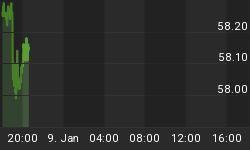Readers have asked what do I mean when I say that the economy has reached a plateau. It's the point where an inflationary monetary policy has driven output, after which symptoms of malinvestments created by inflation will emerge. How long this situation will endure I cannot say. Let me throw a little historical light on the subject. The boom-bust cycle in nineteenth England was always preceded by a severe deviation from the gold standard. This led fairly quickly to an external drain (an outflow of gold). The Bank of England would step in, raise the discount rate and bring about an abrupt tightening in credit. This is how the gold standard hemmed in monetary policy.
Unfortunately, in the absence of a specie standard there is no 'automatic monetary stabiliser'. This means a monetary expansion can continue for many years -- especially if other countries are also inflating -- with only a brief slowdown followed by a rapid pickup as the monetary accelerator is once again pressed to the floor. (The 2000-2001 slowdown in the Australian economy provides a good example of this process).
What makes this situation particularly dangerous is the orthodox view that defines inflation as rising prices. This is a case of taking the symptoms as the cause. Those economists who push this line overlook the fact that where the price effect of rising productivity is offset by an increase in the money supply this becomes the equivalent of a price increase.
The nineteenth century California and Australian gold discoveries made their impact on prices felt fairly quickly. Before this influx of gold increasing productivity had brought about a secular fall in prices which also had the effect of raising real wages. The prices effects of the gold discoveries appear to have worked themselves out by about 1854, after which prices remained fairly stable. John Elliott Cairnes, considered by some to be "the last of the classical economists", argued that the situation was misleading. He calculated that the inflation had actually depreciated gold by something like 20 per cent to 25 per cent. In other words, Elliot had exposed the idea of the stable price level as an economic fallacy. (The Austrians seem to be the only ones who have fully grasped the ramifications of Elliott's line of thinking).
When the "bullion controversy" broke out in England in 1801 with Walter Boyd's open letter to Pitt the Younger the role of money supply on the exchange rate and the balance of trade was dealt with at length and with considerable intellectual effort, much of it brilliant and much of it lost to mainstream economics. What this comes down to is that once England suspended payments in gold, as she did in 1797, the only alternative was unbacked notes and unbacked credit. Every country now finds itself in a similar situation today. Those countries whose money stocks are rising faster than those of their competitors find themselves at a disadvantage, particularly if their currencies are overvalued. (What this amounts to is a situation where the supply of money exceeds the demand for money).
As a rule their balance of trade deteriorates as more and more imports enter the domestic market at the expense of home producers. At the same time their export sectors find themselves becoming increasingly uncompetitive. (Australia is in the position that the foreign demand for raw resources has held up the dollar. What is not generally understood is that much of this demand is itself the product of a very loose monetary policy).
While this is going on the demand for labour increases, even though jobs have been shed in manufacturing, and unemployment continues to fall. But what puzzles some people is that productivity also starts declining. This is only to be expected when a large proportion of the labour force is quickly re-employed. However, the problem of "bottlenecks" eventually emerges. These are usually considered as an unfortunate side-effect of an economy that is growing too fast for some sectors to keep up with. But there is no such thing as an economy "growing too fast". So-called bottlenecks are symptoms of what classical economists called "disproportionality". In today's jargon we would call it disequilibrium.
Inflation has the effect of throwing the capital structure out of kilter. Most economists deny this but by doing so they are assuming that all prices are functional, meaning they have not been distorted. The Austrian analysis, however, shows how inflationary policies corrupt the structure of relative prices causing many to become "dysfunctional". (A dysfunctional price is one that sends a false signal causing the pattern of production to adopt an unsustainable structure, making an economic shakeout inevitable).
So what's the verdict? Well, Australia has been running a reckless monetary policy for about 10 years. From March 1996, when Howard once his first election, to August this year currency increased by 94 per cent, bank deposits by 133 per cent and M1 by 105 per cent. October last year to August this year saw currency rise by 6 per cent, bank deposits by 9 per cent and M1 by 8 per cent. Particularly ominous from my point of view is that between February this year and September the Reserve Bank increased its assets by 25 per cent.
If this is what the Reserve Bank and the Treasury call a sound monetary policy I would hate to experience their idea of an unsound one.















